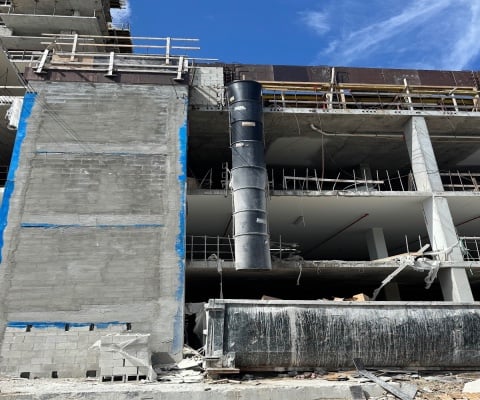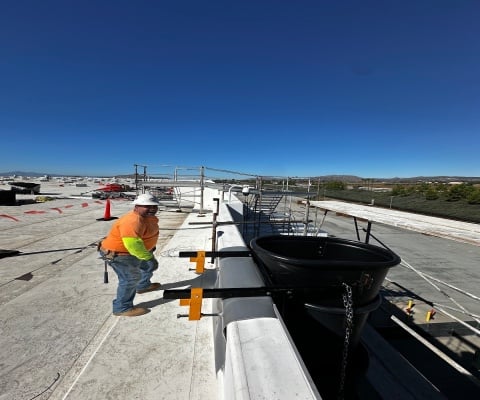Heavy duty debris chutes for demolition are reinforced plastic or steel tubes designed to safely funnel heavy waste such as concrete, rebar, and roofing debris from upper floors to dumpsters below. These systems increase job site safety, meet OSHA standards, and shorten cleanup time on construction or demolition projects.
Efficient waste removal is one of the cornerstones of a well-managed construction or demolition project. Every contractor knows how quickly debris accumulates once teardown begins—concrete chunks, broken tiles, roofing materials, steel fragments, drywall, and other heavy waste can overwhelm a job site in hours.
Without a proper debris chute system in place, moving waste from upper levels to ground dumpsters becomes unsafe, slow, and costly. That’s where heavy-duty debris chutes for demolition come in. These systems revolutionize debris management, allowing controlled, safe disposal of rubble and construction trash from significant heights directly into designated containers.
This complete guide explores everything you need to know about debris chute use in demolition and roofing—from system design and setup to OSHA compliance, maintenance, and efficiency advantages. Whether you manage large-scale demolition sites or handle frequent roofing tear-offs, understanding the best chute systems ensures productivity, safety, and long-term cost savings.
Understanding Debris Chute Systems
A construction debris chute is an enclosed tube designed to control the downward flow of waste from higher elevations to ground-based dumpsters or dumpster bags. The modular sections of each chute, typically four feet long, are joined by heavy-duty chains or rings, allowing contractors to adjust chute height according to project needs.
This design minimizes dust, prevents falling debris from scattering, and drastically improves worksite safety by eliminating manual debris transport across scaffolds or ladders.
For demolition chutes, structural strength and impact resistance are paramount. These systems often handle tons of material daily—chunks of reinforced concrete, rebar, masonry, glass, and roofing debris. A high-quality chute must withstand extreme loads, high impact speeds, and abrasive materials without cracking or collapsing.
Why Choose Heavy Duty Debris Chutes for Demolition
Demolition work produces dense, heavy, irregular waste. A construction trash chute used for demolition must deliver:
- Durability: High-density polyethylene (HDPE) or heavy-gauge steel ensures resilience against sharp, heavy debris.
- Safety and OSHA Compliance: OSHA (Section 1926.852) requires secured chutes for dropping debris from heights above 20 feet.
- High Throughput: Larger diameters—up to 33 inches—maintain steady debris flow without clogging.
- Ease of Assembly: Modular sections enable quick setup and dismantling, crucial for high-turnover demolition projects.
Using heavy-duty debris chutes for demolition reduces worker strain, lowers accident rates, and promotes cleaner, safer job sites.
Construction Chutes vs. Demolition Chutes
Both chute types serve the same purpose—safe debris removal—but differ in material strength, diameter, debris capacity, and longevity.
Construction Chutes are made from lightweight HDPE plastic, typically ranging from 21 to 26 inches in diameter. They are best suited for moderate debris such as drywall, wood, and insulation, commonly used in roofing, renovation, and small-scale construction work. Their expected lifespan is moderate, ideal for light to medium-duty applications.
Demolition Chutes, by contrast, are built from reinforced HDPE or steel and range from 26 to 33 inches in diameter. They are designed for heavy debris such as concrete, steel, and plaster, making them essential for large structural teardowns and industrial demolition projects. Their lifespan is long-term and built to handle continuous, high-impact use.
Demolition chutes also feature reinforced collars, steel chains, and expanded hopper openings, making them ideal for multi-story demolitions and heavy debris loads.
Choosing the Right Size Debris Chute
The correct chute diameter directly impacts efficiency, safety, and job performance.
- 21-inch chutes: Best for roofing debris, light demolition, or residential remodeling.
- 26-inch chutes: Ideal for mixed-use construction and medium-scale commercial demolition.
- 33-inch chutes: Designed for heavy demolition projects with concrete, rebar, or dense debris.
Selecting the right size prevents blockages, improves debris flow, and matches each chute to the project’s waste volume and material type.
Key Components of a Debris Chute System
A complete construction waste chute setup includes:
- Hopper Sections: Large funnel openings for easy debris entry.
- Modular Chute Tubes: Four-foot conical sections creating a continuous path.
- Chains and Rings: Galvanized, heat-treated for secure load-bearing connections.
- Anchoring Systems: Roof, scaffold, or window mounts ensuring vertical stability.
- Electric Winches: For raising, lowering, or repositioning chute assemblies.
- Support Frames: Outriggers or parapet brackets maintaining alignment.
- Dumpster Bags or Containers: Collection points that prevent dust and spillage.
Installation Best Practices
1. Site Preparation:
Inspect mounting areas and ensure adequate clearance for dumpsters.
2. Proper Anchoring:
Attach to stable parapet walls or scaffolds using steel brackets and chains.
3. Section Assembly:
Secure chute modules vertically for smooth transitions.
4. Install Hopper Doors:
Add self-closing doors at each disposal level.
5. Landing Zone Protection:
Fence or barricade discharge zones.
6. Dust Control:
Install dust gaiters or liners.
7. Mechanical Support:
Use electric winches for vertical adjustments.
8. Inspection:
Test load capacity and alignment before use.
Bottom line: A well-installed chute system improves safety, minimizes downtime, and enhances cleanup efficiency on every level.
OSHA Safety Requirements
All construction chutes must comply with OSHA regulations:
- Guardrails at least 42 inches high around openings.
- Hopper openings below the top floor must remain closed when not in use.
- Chutes must be securely attached to prevent collapse.
- Drop zones must be fenced or barricaded to prevent public access.
- Chutes must withstand debris impact and frictional heat.
Compliance ensures project safety and protection against liability.
Maintenance and Operation
Proper upkeep extends chute lifespan and performance:
- Clear debris regularly to prevent buildup.
- Inspect chains, joints, and fasteners daily.
- Lubricate hinges monthly.
- Replace damaged sections immediately.
- Clean liners with mild detergent.
- Store sections horizontally in dry spaces.
- Apply anti-corrosion coatings annually for steel chutes.
Bottom line: Regular inspection and maintenance ensure continuous safe operation and longer chute life.
Incorporating Dumpster Bags and Rubbish Chute Systems
At the discharge zone, dumpster bags or roll-off dumpsters collect debris efficiently. Using compatible containers prevents spillage and speeds cleanup. Reinforced woven bags offer a reusable, portable waste-management solution.
A professional rubbish chute system ensures a sealed connection between chute and container, protecting against dust pollution and enhancing environmental compliance.
Accessories to Improve Performance
To maximize safety and efficiency:
Safety Accessories
- Protective liners guard interior walls.
- Dust gaiters seal joints.
- Impact absorbers disperse energy at bends.
Efficiency Accessories
- Picking bars ease chute repositioning.
- Electric winches automate vertical adjustments.
High-quality accessories ensure reliable operation across multiple job cycles.
Electric Winches in Construction Trash Chutes
For trash chutes for construction exceeding three stories, electric winches are indispensable. They automate raising and lowering, reducing manual strain and setup time by half. Winches maintain even chain tension across sections, minimizing joint stress and prolonging system life.
Common Issues and Troubleshooting
-
Blockages:
Caused by moisture or oversized debris—use anti-stick liners.
-
Noise Complaints:
Install sound-damping materials.
-
Static Buildup:
Apply anti-static coatings on plastic chutes.
-
Weather Damage:
Avoid UV exposure or freezing moisture in joints.
-
Swinging Columns:
Tighten modules to resist high winds.
Preventive checks keep waste management efficient and OSHA-compliant.
Environmental and Economic Impact
Reusing modular plastic chutes instead of single-use waste removal tools reduces landfill contribution and carbon emissions. Contractors using composite or HDPE debris chutes report up to 22% lower fuel costs due to lighter transport weight. Combined with recyclable dumpster bags, these systems promote environmentally responsible demolition practices.
Many demolition contractors now pair these systems with on-site recycling bins, separating materials like concrete, metal, and wood for reclamation. This approach saves hauling costs, supports LEED and EPA sustainability goals, and minimizes the overall carbon footprint of each project.
These improvements not only appeal to environmentally conscious clients but also demonstrate a company’s commitment to green construction standards and sustainable business operations.
Why HodChutes Leads in Heavy Duty Debris Chutes
HodChutes is the industry’s trusted provider of professional-grade debris chute systems for construction and demolition.
Their heavy-duty debris chutes for demolition feature reinforced 32-inch openings, high-molecular-weight polyethylene walls, and galvanized chain assemblies for exceptional durability and safety. Each chute is optimized for smooth debris flow, reducing maintenance and increasing project efficiency.
HodChutes also provides complete accessory lines—electric winch kits, debris lids, dumpster bags, outriggers, and gate systems—customized for any scaffold or roofing setup.
Beyond product excellence, HodChutes offers full support through digital installation guides, OSHA-compliant safety tutorials, and on-site consultations. Contractors worldwide trust HodChutes for dependable debris-management solutions that exceed industry standards.
HodChutes delivers construction debris chute systems nationwide—serving contractors, roofers, and demolition professionals across the United States with fast shipping, expert support, and guaranteed product quality.
FAQ: Heavy Duty Debris Chutes for Demolition
What are heavy-duty debris chutes used for in demolition?
They allow for safe and controlled transport of heavy materials directly to ground containers, preventing manual lifting and minimizing dust and injury risks.
Are debris chutes mandatory for multi-story construction?
Yes. OSHA requires enclosed chutes for dropping debris from heights above 20 feet.
How long do demolition chutes last?
With proper maintenance, HDPE and steel chutes can last for hundreds of uses and multiple projects.
Can you attach debris chutes to scaffolding?
Yes. Using scaffold brackets or outriggers ensures secure anchorage without damaging building facades.
How do you choose between plastic and steel debris chutes for demolition?
Choose based on debris type and job duration. Plastic chutes are lightweight and suited for small to medium-impact projects, while steel chutes are recommended for long-term or high-impact demolition requiring maximum durability.
Conclusion
Safe and efficient debris management defines successful construction and demolition operations. A well-selected system—especially heavy-duty debris chutes for demolition—empowers contractors to streamline workflow, reduce costs, and maintain OSHA and environmental compliance.
Whether managing high-rise demolitions, roofing tear-offs, or commercial renovations, properly installed chute systems ensure that debris moves safely from start to finish.
Explore HodChutes’ full line of construction chutes, roofing chutes, trash chutes, and rubbish chute systems engineered to withstand the toughest demolition challenges.
Call HodChutes today to request a custom quote or same-day shipping for your next demolition project.
We hope you found this blog post on Heavy Duty Debris Chutes for Demolition useful. Be sure to check out our post, House Demolition – Things You Need To Know, for more great tips!
Have Experience in the Moving Industry? Want an Additional Income Stream? Work With All Around Moving!
Start a business in the moving industry and make a good income. Click here to learn more.







